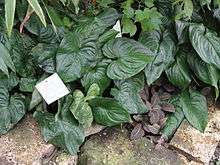Cyanastrum
Cyanastrum is a genus of plants in the family Tecophilaeaceae, native to tropical Africa. It contains three currently recognized species.[2]
| Cyanastrum | |
|---|---|
 | |
| Cyanastrum cordifolium | |
| Scientific classification | |
| Kingdom: | Plantae |
| Clade: | Tracheophytes |
| Clade: | Angiosperms |
| Clade: | Monocots |
| Order: | Asparagales |
| Family: | Tecophilaeaceae |
| Genus: | Cyanastrum Oliv.[1] |
| Type species | |
| Cyanastrum cordifolium | |
| Synonyms[2] | |
|
Schoenlandia Cornu | |
Description
Cyanastrum has a corm that lacks a protective tunic. The leaf and the inflorescence emerge from different corm-scales, and are present at different times. The leaf has a short stalk, is basal and is usually single. The inflorescence is a raceme, often with no bracts, the tepals are blue and the flowers have parts in sixes.[3]
Species
The following species are recognized:[2]
- Cyanastrum cordifolium Oliv. -- Nigeria, Cameroon, Equatorial Guinea, Gabon, Congo-Brazzaville, Zaire (Congo-Kinshasa)
- Cyanastrum goetzeanum Engl. -- Tanzania
- Cyanastrum johnstonii Baker in D.Oliver & auct. suc. (eds.) -- Tanzania, Zambia, Mozambique, Zaire (Congo-Kinshasa)
gollark: ++remind "september 24" it is already too late
gollark: Nobody needed those environment variables anyway, because it didn't crash.
gollark: Apparently you used to be able to use some internal Python API to get the location of argv/argc but they broke it.
gollark: I read somewhere that the environment list thing was near argv in memory, so it finds a common environment variable's location using `getenv`, scans backward until it finds `python3`, then randomly overwrites things.
gollark: Do you like my `argv[0]`-setting code, by the way? I think that's what it has to use to deceive `ps ax`.
References
- Oliver, Daniel. 1891. Hooker's Icones Plantarum v 20, t. 1965, Cyanastrum cordifolium
- Kew World Checklist of Selected Plant Families, Cyanastrum
- Klaus Kubitzki (2013). Flowering Plants. Monocotyledons: Lilianae (except Orchidaceae). Springer Science & Business Media. p. 434. ISBN 978-3-662-03533-7.
This article is issued from Wikipedia. The text is licensed under Creative Commons - Attribution - Sharealike. Additional terms may apply for the media files.